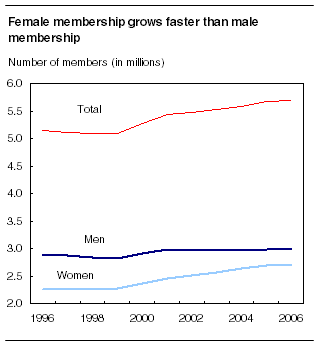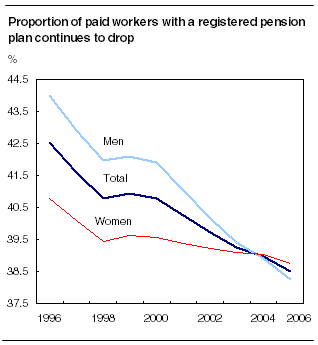Common menu bar links
Pension plans in Canada
Archived Content
Information identified as archived is provided for reference, research or recordkeeping purposes. It is not subject to the Government of Canada Web Standards and has not been altered or updated since it was archived. Please "contact us" to request a format other than those available.

After several years of growth, membership in Canada's 15,130 active registered pension plans (RPP) remained virtually unchanged in 2005, according to new data from an annual census of these employer-sponsored plans.

As of January 1, 2006, active RPPs covered just under 5.7 million members, up only 0.4%, or about 20,000, from the year before. This pace of growth was substantially slower than the annual rates recorded since the turn of the millennium.
Data from the Survey of Pension Plans in Canada show that more and more women in the paid workforce are being covered by RPPs. In fact, women accounted for the net increase in the total membership during 2005.
The number of men belonging to an RPP remained unchanged at 2.98 million, while the number of women increased 0.7% to just over 2.71 million.
Note to readersRegistered pension plans (RPPs) are established by employers or unions for employees. These data come from the Pension Plans in Canada Survey at January 1, 2006, which provides information on terms and conditions, membership and contributions. Membership is defined as active members of the pension plan currently making contributions to the pension plan or for whom contributions are being made. Active membership also includes persons who have temporarily left their employment (e.g., those on maternity leave or temporary lay off) but who are expected to return. Vested former members entitled to deferred pensions and retired persons are excluded. There are two main types of RPPs: defined contribution plans and defined benefit plans. A defined contribution plan is an RPP that specifies the contributions made by the employee, if the plan is contributory, as well as by the employer. Pension benefits paid are a function of accumulated contributions and investment returns. In contrast, a defined benefit plan is an RPP that defines the benefits to be paid according to a formula stipulated in the plan text. The employer's contributions are not predetermined, but are a function of the cost of providing the promised pension. An analysis of the funding situation of defined benefit RPPs will be released this fall. Upcoming revisions Additional, more accurate information has been received for 2006 pertaining to a large registered pension plan included in the Pension Plans in Canada estimates. This new information affects the number of members by area of employment, primarily in the Northwest Territories, Yukon and Nunavut, while there is a minor impact across all provinces. The information has been incorporated in the current 2006 release and revisions to previously published estimates from 2003 to 2005 will be available soon. For more information, contact Bruno Pépin (613-951-4023; fax: 613-951-4296; bruno.pepin@statcan.gc.ca), Income Statistics Division. |
As of January 1, 2000, men accounted for 55.1% of all members, and women 44.9%. By January 1, 2006, the proportion of men had declined to 52.3%, while the share of women had increased to 47.7%.
RPPs are retirement benefit programs that are provided voluntarily by employers or by unions in both the public and private sectors. As of January 1, 2006, about 4 out of every 10 paid workers were participating in an RPP.
Continued growth in public sector membership; decline in private sector
While the overall number of active members of RPPs remained relatively stable, the public sector added 37,000 members in 2005.
As of January 1, 2006, membership in public sector plans amounted to just under 2.7 million, up 1.4% from the previous year. At the same time, private sector plans had just under 3.0 million members, a 0.5% decline.
Public sector membership accounted for 47.3% of the total membership in RPPs as of January 1, 2006, up from 46.1% as of January 1, 2000.
Since 2001, the public sector has added about 170,000 members, more than three times the 50,000 additional members in the private sector. Growth in female membership accounted for 80% of this increase.
The decline in private sector membership in 2005 was the first since 2001.
The biggest gain in 2005 occurred in the finance, insurance and real estate industries, where membership rose by 12,910. Construction industries followed, adding 13,170 members. However, these increases were more than offset by a loss of 28,000 members in the manufacturing sector.
The manufacturing sector continues to suffer from employment losses in the textile, wood, paper, primary metals and electrical equipment industries.
Since 2000, RPP membership in the manufacturing sector has declined by more than 80,000. However, the construction, finance and community business industries showed substantial increases over the same period.
Pension coverage continues to edge down
The proportion of paid workers with a registered pension plan continued to decline in 2005, falling half a percentage point to 38.5%. Despite favourable labour market conditions, RPP membership grew at a slower pace than employment.
Both men and women had lower coverage rates in 2005, but coverage rates among men declined at a faster pace. For the second year in a row, coverage rates for women were higher than men.

In 2005, 38.7% of female paid workers had a registered pension plan, compared to 38.3% of male paid workers.
The decline in coverage rates for women has not been as sharp because their employment is concentrated more in industries where registered pension plans are offered. These include health care and social assistance, educational services and public administration.
Both the public and private sectors experienced declines in the proportion of the paid workforce covered by an RPP. In 2005, the coverage rate for the public sector was 84.0%, about one percentage point lower than in the previous year, while the coverage rate in the private sector declined by half a point to 25.9%.
The vast majority of workers belong to "defined benefit plans"
The vast majority of RPP members belong to "defined benefit plans". These are RPPs that define the benefits to be paid according to a formula stipulated in the plan text.
As of January 1, 2006, about 4.6 million workers were members of a defined benefit plan, virtually unchanged from the previous year. This level has increased by only 30,700 since 2000.
An increase of about 159,700 in female membership was mostly offset by a decline of 129,000 in male membership. Defined benefit plans still remain the most important type, accounting for more than 80% of overall membership.
A second type of RPP is the defined contribution plan, which specifies the employee's contributions, if the plan is contributory, as well as the employer's contributions. The vast majority (82.5%) of members of these plans were working in the private sector.
As of January 1, 2006, defined contribution plans had 893,400 members, up 0.9% from the previous year. This gradual upward trend has been observed for a number of years. The number of members with a defined contribution plan now accounts for 15.7% of the total RPP membership, up from 14.6% in 2001.
Alberta leads growth in number of members
Four provinces registered gains in RPP membership in 2005. The strongest occurred in Alberta, where membership grew by 22,700, or 4.4%, to just below 536,300. This increase consisted of 12,000 men and 10,700 women.
As of January 1, 2006, 426,200 Alberta members had a defined benefit pension plan, up 5.0% from the previous year. The strong performance of Alberta's economy over the last few years has been an important factor contributing to the growth in membership since 2000.
Alberta accounted for 9.4% of all membership in 2005, up from 9.1% in the previous year. This was also reflected in the province's coverage rate, which was up by almost one percentage point to 33.1%.
The largest decline occurred in Ontario, where membership fell by 5,020 members to just under 2.2 million. The decline occurred mainly among men, and was concentrated in the manufacturing and trade industries.
Contributions hit another record high
Total employee and employer contributions to RPPs reached another record high of $37.4 billion in 2005, up $2.9 billion from the previous year. This was the sixth consecutive annual gain and the second year in a row that contributions exceeded $30 billion.
Employer contributions accounted for about 70% of the total contributions in 2005 compared to 64% in 2001.
Employee contributions have also continued to grow, reaching a peak of $11.2 billion in 2005, about $1.1 billion more than in the previous year.
Employer contributions for current service increased 3.1% in 2005 to $18.6 billion, while special payments for unfunded liabilities and solvency deficiencies amounted to $7.6 billion.
Employers continued to inject funds into defined benefit pension plans to ensure adequate financing after previous disappointing returns on investment in 2001 and 2002 and a low interest rate environment. Since 2003, special payments have reached $19.8 billion.
Available on CANSIM: tables 280-0008 to 280-0026.
Definitions, data sources and methods: survey number 2609.
To obtain statistical tables providing key information, custom tabulations (74C0002, various prices) or more information, or to enquire about the concepts, methods or data quality of this release, contact Client Services (toll-free 1-888-297-7355; 613-951-7355; fax: 613-951-3012; income@statcan.gc.ca), Income Statistics Division.

